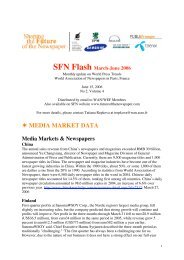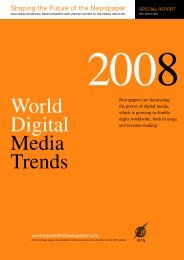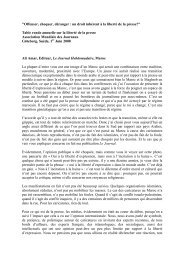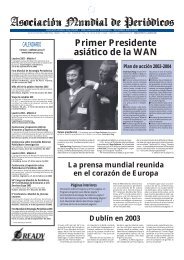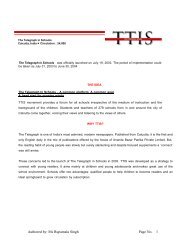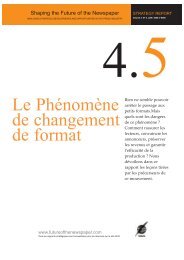WORLD PRESS TRENDS - World Association of Newspapers
WORLD PRESS TRENDS - World Association of Newspapers
WORLD PRESS TRENDS - World Association of Newspapers
Create successful ePaper yourself
Turn your PDF publications into a flip-book with our unique Google optimized e-Paper software.
UKRAINE<br />
Commentary – Mikhail Veisberg, President <strong>of</strong> the Ukrainian Newspaper Publishers <strong>Association</strong> (extracts from thesis: Non-political view on<br />
the development <strong>of</strong> newspaper publishing industry)<br />
Generally, all over Ukraine (according to Ukraine Media<br />
Monitoring), TV’s share <strong>of</strong> advertising is absurdly high. It<br />
amounted to 75% in 2002, with newspapers taking 11%, outdoor<br />
advertising 10%, and radio 4%. For the last few years there has<br />
been a general increase in advertising across all media, but TV’s<br />
share has been growing faster, and at the expense <strong>of</strong> newspapers<br />
and outdoor advertising. It is due to the active development <strong>of</strong><br />
so-called multiregional channels - Novyi, ICTV, STB – and the<br />
relatively low price for advertising on TV. In fact, the regional<br />
TV studios accounted for only US$26 million <strong>of</strong> the total US$636<br />
million generated by TV in 2002.<br />
In Ukraine, national and regional newspapers are clearly<br />
distinguishable. The former are more dependent on politics and<br />
actively compete with each other and the regional press. The<br />
latter are less dependent on politics and easily compete with<br />
the central press in their regions (local news, increased<br />
pr<strong>of</strong>essionalism and local patriotism <strong>of</strong> the readers contribute<br />
to this).<br />
It’s not easy to estimate the number <strong>of</strong> industry players, as<br />
market statistics are not reliable. According to the State<br />
Committee on Information, there are 16,000 registered<br />
publications, <strong>of</strong> which 6,700 are national and 9,300 regional.<br />
The committee is unable to trace how many <strong>of</strong> them are actually<br />
published, however. There are also 900 communal property<br />
newspapers, 300 state-owned and 400 <strong>of</strong>ficial party newspapers.<br />
The Ukrainian Post Office’s subscription catalogues include<br />
3,640 publications; subscription for the nationwide press slightly<br />
exceeds subscription for regional publications. According to the<br />
data <strong>of</strong> the Ukraine Press Monitoring company there are more<br />
than 4,000 publications, including 2,600 newspapers and 1,400<br />
magazines.<br />
In 2002 research by UNPA identified that:<br />
- people read newspapers <strong>of</strong>ten (55% - several times a week,<br />
88% - at least once a week)<br />
- newspapers are read mostly at home and for almost 60 minutes<br />
- newspaper readers seek news (75%) and useful information<br />
(72%)<br />
- the main topics the reader is interested in are local news<br />
(90%), national news and TV programme listings (88%),<br />
health (87%), foreign news and weather (86%)<br />
- the readers actively use advertising materials, paying most<br />
attention to the ads connected with training and jobs, medical<br />
care, food and drinks<br />
- what is most important is that the readers did not see any<br />
drawbacks in the newspapers<br />
- the readers are not rich, do not plan substantial purchases<br />
and want the newspapers to become cheaper.<br />
POPULATION<br />
Urban population by age and sex<br />
All individuals Male Female<br />
000 % 000 % 000 %<br />
12-15 1,295 8 658 8 637 7<br />
16-19 1,447 8 719 9 727 8<br />
20-29 3,485 20 1,762 22 1,723 19<br />
30-39 3,345 19 1,629 20 1,716 19<br />
40-54 4,967 29 2,266 28 2,701 30<br />
55-65 2,656 15 1,147 14 1,510 17<br />
Total 17,196 100 8,181 100 9,014 100<br />
Source: Taylor Nelson S<strong>of</strong>res<br />
Households<br />
Households<br />
000 %<br />
1 person 937 5<br />
2 people 3,313 19<br />
3 people 5,820 34<br />
4 people 4,769 28<br />
5 people 1,626 9<br />
6 or more people 681 4<br />
Unknown 51 0<br />
17,196 96<br />
without children 11,801 69<br />
with children 5,395 31<br />
with children aged 7-11 2,420 14<br />
with children aged 4-6 1,009 6<br />
with children aged 2-3 736 4<br />
with children 1 year old 300 2<br />
with children under 1 year 298 2<br />
Total 17,196 100<br />
Source: Taylor Nelson S<strong>of</strong>res 22,591<br />
Adult population by financial status<br />
Adults Male Female<br />
000 % 000 % 000 %<br />
AB 459 3 241 3 218 3<br />
C 4,179 26 2,134 28 2,045 24<br />
D 6,389 40 3,015 40 3,374 40<br />
E 3,871 24 1,579 21 2,292 27<br />
E 1,003 6 554 7 448 5<br />
Total 15,900 100 7,523 100 8,377 100<br />
Source: Taylor Nelson S<strong>of</strong>res<br />
A= Prosperous<br />
B= Well-to-do<br />
C= Moderate income<br />
D= Poor<br />
E= No answer<br />
Housewives (co-habiting persons)<br />
Housewives<br />
000 %<br />
16-19 7 1<br />
20-29 108 22<br />
30-39 205 41<br />
40-54 178 36<br />
55-65 2 0.5<br />
Total 500 100<br />
Source: Taylor Nelson S<strong>of</strong>res<br />
<strong>WORLD</strong> ASSOCIATION OF NEWSPAPERS - <strong>WORLD</strong> <strong>PRESS</strong> <strong>TRENDS</strong> 2003 293





